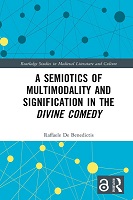Chapter 1 A Semiotic Theory of Multimodality for the Divine Comedy
Proposal review
| dc.contributor.author | De Benedictis, Raffaele | |
| dc.date.accessioned | 2023-08-28T09:09:47Z | |
| dc.date.available | 2023-08-28T09:09:47Z | |
| dc.date.issued | 2024 | |
| dc.identifier.uri | https://library.oapen.org/handle/20.500.12657/75834 | |
| dc.description.abstract | In this chapter the author lays out a theoretical groundwork for a semiotic theory of multimodality in the Divine Comedy. The analysis is not comprehensive of all modes, but limited to key-modal forms that Dante’s text authorizes in order to understand the formation of codes based on different forms of articulation and how different modes of articulation may interact with one another in a multimodal arrangement to achieve strong, functional signification in general and, where necessary, working toward the formation of new ontologies intimating human transcendence in terms of signification. | en_US |
| dc.language | English | en_US |
| dc.subject.other | semiotics, multimodality, divine comedy, Literary Criticism, Multiliteracy, language-as-writing, signification | en_US |
| dc.title | Chapter 1 A Semiotic Theory of Multimodality for the Divine Comedy | en_US |
| dc.type | chapter | |
| oapen.identifier.doi | 10.4324/9781003397298-1 | en_US |
| oapen.relation.isPublishedBy | 7b3c7b10-5b1e-40b3-860e-c6dd5197f0bb | en_US |
| oapen.relation.isPartOfBook | d9a929d5-7fb2-46ac-81ae-212db9b67f11 | en_US |
| oapen.relation.isFundedBy | e2ee76d0-068c-4dde-ad41-66024722648d | en_US |
| oapen.relation.isbn | 9781032497334 | en_US |
| oapen.relation.isbn | 9781032501925 | en_US |
| oapen.imprint | Routledge | en_US |
| oapen.pages | 65 | en_US |
| peerreview.anonymity | Single-anonymised | |
| peerreview.id | bc80075c-96cc-4740-a9f3-a234bc2598f1 | |
| peerreview.open.review | No | |
| peerreview.publish.responsibility | Publisher | |
| peerreview.review.stage | Pre-publication | |
| peerreview.review.type | Proposal | |
| peerreview.reviewer.type | Internal editor | |
| peerreview.reviewer.type | External peer reviewer | |
| peerreview.title | Proposal review | |
| oapen.review.comments | Taylor & Francis open access titles are reviewed as a minimum at proposal stage by at least two external peer reviewers and an internal editor (additional reviews may be sought and additional content reviewed as required). |

